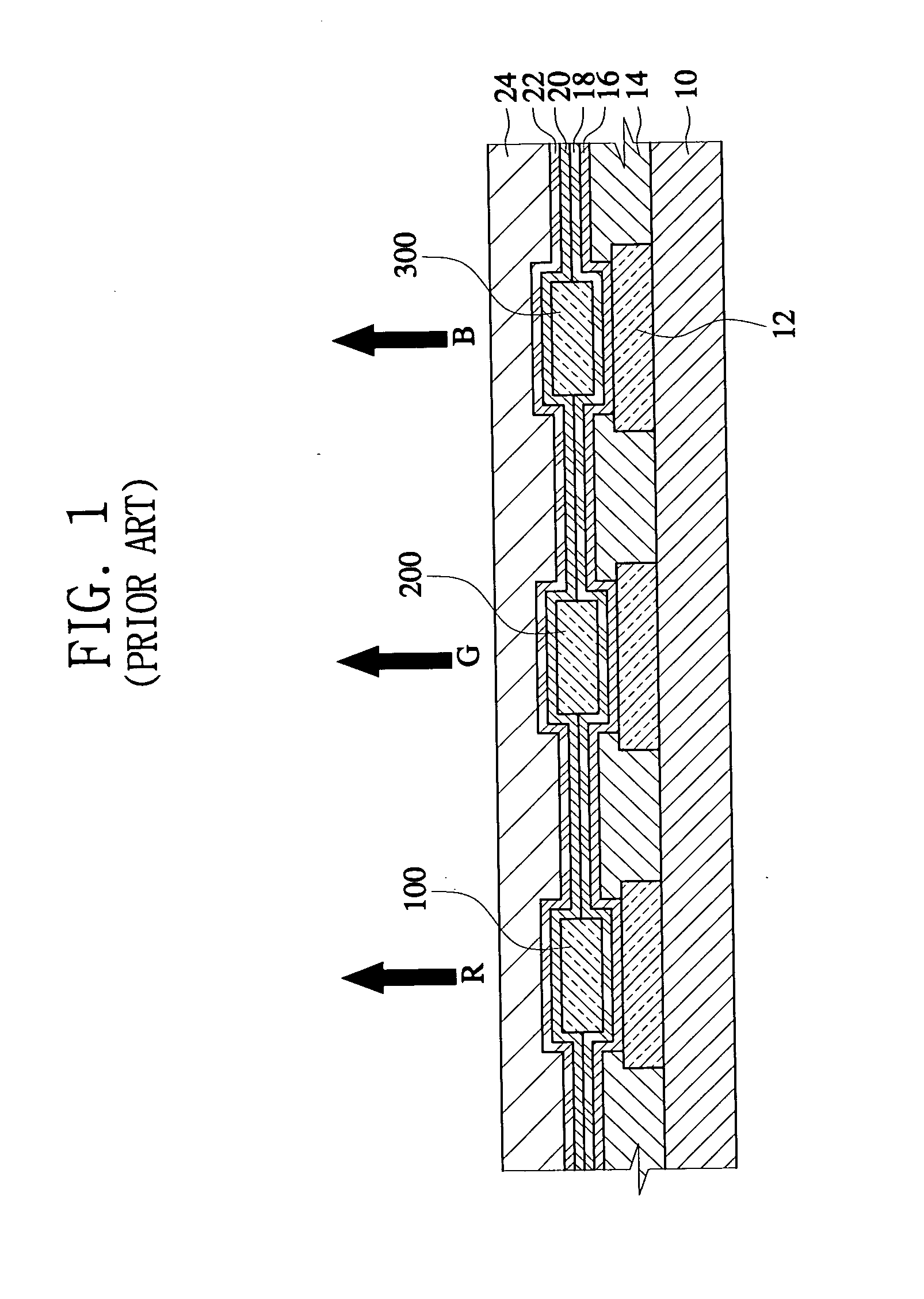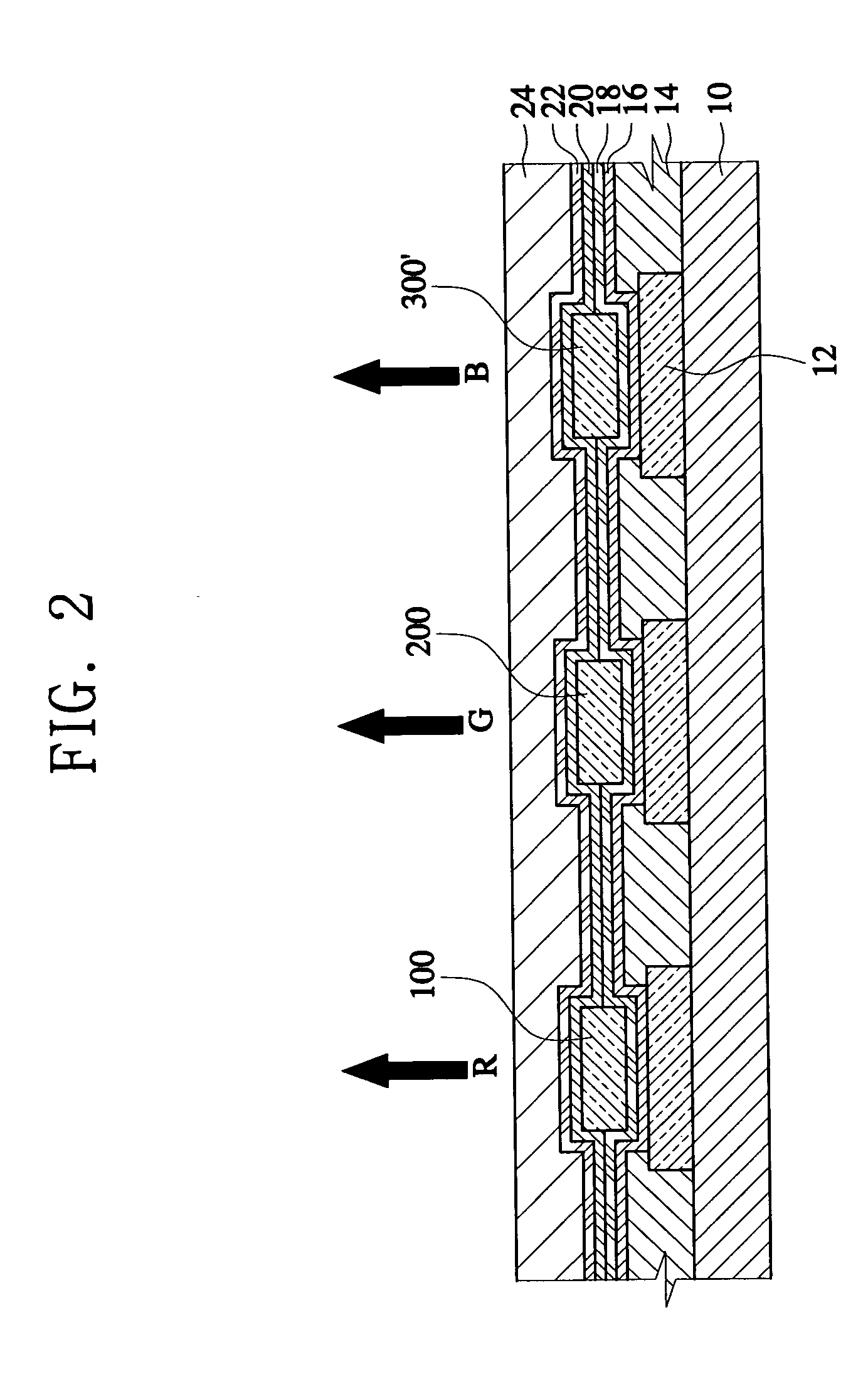Full color organic electroluminescent device
- Summary
- Abstract
- Description
- Claims
- Application Information
AI Technical Summary
Benefits of technology
Problems solved by technology
Method used
Image
Examples
examples 1-3
[0047] Fabrication of the Blue Fluorescent Device
[0048] Ultrasonic cleaning is performed on an ITO substrate (i.e., first electrode) patterned to a width of 80 μm and a UV / O3 process is then performed for 15 minutes. A small molecular hole injecting layer (IDE 406; fabricated by IDEMITZ with a HOMO value of 5.1 eV) is then vacuum deposited at a pressure of 8×10−7 mbar Pa to a thickness of 600 Å. A small molecular hole transporting layer (IDE 320; fabricated by IDEMITZ with a HOMO value of 5.4 eV) is deposited at the same pressure to a thickness of 300 Å. For the emitting layer of the blue fluorescent device, IDE 140 (fabricated by IDEMITZ corporation with a HOMO value of 5.7 eV and a LUMO value of 2.7 eV) as a host and IDE 105 (fabricated by IDEMITZ and has a HOMO value of 5.4 eV and a LUMO value of 2.6 eV) as a dopant at a concentration of 7% by weight are vacuum deposited to a thickness of 200 Å.
[0049] For the hole blocking layer, Aluminum(III)bis(2-methyl-8-quinolinato)-4-pheny...
examples 4 and 5
[0050] Test cells are fabricated by the same method as Examples 1-3, except that HBM010 (PL max: 398 / 422 nm; fabricated by COVION) is deposited to thicknesses of 50 Å and 100 Å, respectively for Examples 4 and 5 for the hole blocking layers instead of Balq.
examples 6-9
[0051] Fabrication of the Red Phosphorescent Device
[0052] Ultrasonic cleaning is performed on an ITO substrate (i.e., first electrode) patterned to a width of 80 μm and a UV / O3 process is then performed for 15 minutes. A small molecular hole injecting layer (IDE 406; fabricated by IDEMITZ with a HOMO value of 5.1 eV) is then formed to a thickness of 600 Å by vacuum deposition at a pressure of 8×10−7 mbar Pa. A small molecular hole transporting layer (IDE 320; fabricated by IDEMITZ with a HOMO value of 5.4 eV) is deposited at the same pressure to a thickness of 300 Å. For the emitting layer of the red phosphorescent device, 4,4′-N,N′-dicarbazole biphenyl(CBP; fabricated by UDC) as a host and PtOEP (fabricated by UDC) as a dopant at a concentration of 10% by weight are vacuum deposited to a thickness of 300 Å.
[0053] For the hole blocking layer, Aluminum(III)bis(2-methyl-8-quinolinato)-4-phenylphenolate (Balq; fabricated by UDC) is deposited to thicknesses of 20 Å, 50 Å and 100 Å, re...
PUM
| Property | Measurement | Unit |
|---|---|---|
| Fraction | aaaaa | aaaaa |
| Fraction | aaaaa | aaaaa |
| Thickness | aaaaa | aaaaa |
Abstract
Description
Claims
Application Information
 Login to View More
Login to View More - R&D
- Intellectual Property
- Life Sciences
- Materials
- Tech Scout
- Unparalleled Data Quality
- Higher Quality Content
- 60% Fewer Hallucinations
Browse by: Latest US Patents, China's latest patents, Technical Efficacy Thesaurus, Application Domain, Technology Topic, Popular Technical Reports.
© 2025 PatSnap. All rights reserved.Legal|Privacy policy|Modern Slavery Act Transparency Statement|Sitemap|About US| Contact US: help@patsnap.com



